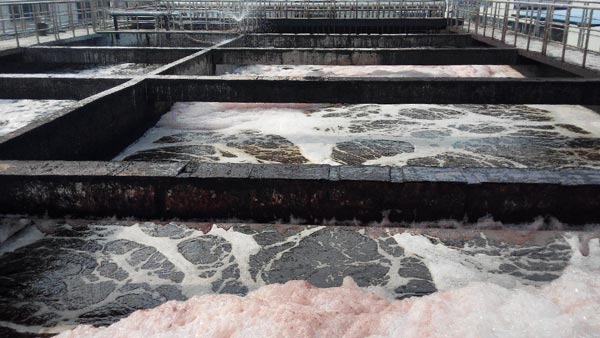Simultaneous Nitrification and Denitrification ( SiNAD ®) system originated from principles of oxidation ditch process is a biological method for the removal of organic carbon (COD) and nitrogen (NH4+-N) efficiently from wastewater with low aeration energy expense. The system which integrates anaerobic, anoxic, aerobic and recycling process provides an excellent environment for anaerobic heterotrophic facultative organisms and aerobic autotrophic organisms to work together and to degrade various organic substances from wastewater.
Compared to other conventional processes, SiNAD®nitrification process has the following advantages:
1. Dissolved Oxygen Controlled Aeration System (DO-CON Aeration System)
SiNAD®nitrification process adopts DO-CON aeration technology to monitor and control dissolved oxygen level in wastewater. The technology equips a new type of polyurethane aeration diffuser to deliver uniform and tiny bubbles providing substantial and efficient mass transfer of oxygen into the water. Due to its slower ascending rate resulting in a greater amount of contact time with water, the diffused tiny bubbles optimize longer retention time and allow for the transfer of more oxygen per volume of air supplied over other techniques. The special engineered diffuser enables no bubble coalescence in the process and controls DO level lowest allowed rate at 0.2 mg/L. The patented retrievable design allows for access to diffusers for maintenance or replacement without dewatering the tank that eliminates disruption of normal wastewater processing through the facility when maintenance of fine bubble diffusers is required.
2. Precision dissolved oxygen control system AMOX
The SiNAD®nitrification technology equips a new type of polyurethane aeration diffuser to monitor and control dissolved oxygen level within certain range by optimizing the layout of the aeration hose. The AMOX system can save 25 % oxygen consumption than the conventional activated sludge process. When the dissolved oxygen level is controlled at a low level ( 0.3 – 0.5 mg/L ), two aspects of performance can be improved:

3. Cultivation and Environmental Control of Bacteria Used in Engineering
SiNAD®nitrification technology uses special enhanced species as inoculants enabling activated sludge to rapidly transform and achieve higher performance level as special strains.
Screened and isolated from natural environment, inoculants s are domesticated and strengthened to obtain a mixture with hundreds of species in proportion, with a microbial content of 1 billion CFU/g. The corresponding enzyme and nutrients were added to form the inoculation bacteria of SiNAD®nitrification process.
The inoculants can form activated sludge or biofilm in short time, greatly shortening the startup process of conventional biological process and saving 2 / 3 time. The degradation rate of organic matter using inoculants is 20 ~ 30 times faster than conventional sludge, which indicates high removal efficiency and fast degradation rate for pollutants.
Inoculants contain special species for hardly degraded substances such as aromatics, heterocyclics, halohydrocarbons, ammonia nitrogen and other substances with poor biodegradability, so that the COD of effluent can meet the required standard.
Inoculants can be customized based on wastewater operating conditions and influent characteristics to form a variety of preparation products used in wastewater treatment in petroleum and petrochemical, coal chemical, papermaking, medical, printing and dyeing industries
The efficient sludge lifting, sewage lifting and dissolved oxygen control system create a great growth environment for microorganisms to strengthen the distribution of microbial diversity in the system, so as to achieve excellent treatment effect.
4. High Sludge Concentration
The sludge concentration in conventional activated sludge process is generally 2 – 5 g/L. The SiNAD®nitrification process enables the sludge concentration to reach 8 – 10 g/L, which can effectively improve the volumetric load per unit volume, reduce land use and construction investment, and increase impact resistance to shock loads.
Shaoxing Shangyu Xinli Chemical Industry is committed to the development and manufacture of high-performance organic pigment products that meet environmental protection and physicochemical standards. The product line includes five series which are mainly organic pigments and supplemented by pigment intermediates. Including benzimidazolone series, chromophores series, azo series, phthalocyanine series, pigment intermediates series.
The wastewater discharged from the production department has high COD, ammonia nitrogen, and total nitrogen. Base on the characteristics of the wastewater and the previous engineering experience, the SiNAD®nitrogen release short-cut nitrification and denitrification process is selected. The design and operation data are as follows :
| No. | Items | Influent Index | Effluent Index | Actual Operating Value Average Data in May | Unit | |
| Influent | Effluent | |||||
| 1 | Water Quantity | <600 | 680 | t/d | ||
| 2 | CODCr | <8000 | <500 | 7536 | 298 | mg/L |
| 3 | BOD5 | <5000 | – | mg/L | ||
| 4 | NH4-N | <500 | <80 | 228 | 8 | mg/L |
| 5 | NOX-N | <100 | mg/L | |||
| 6 | TN | <650 | <100 | 618 | 24 | mg/L |
| 7 | pH | 6~9 | 6~9 | 8.5 | 7.8 | |
| 8 | Water Temperature | <30℃ | ||||
